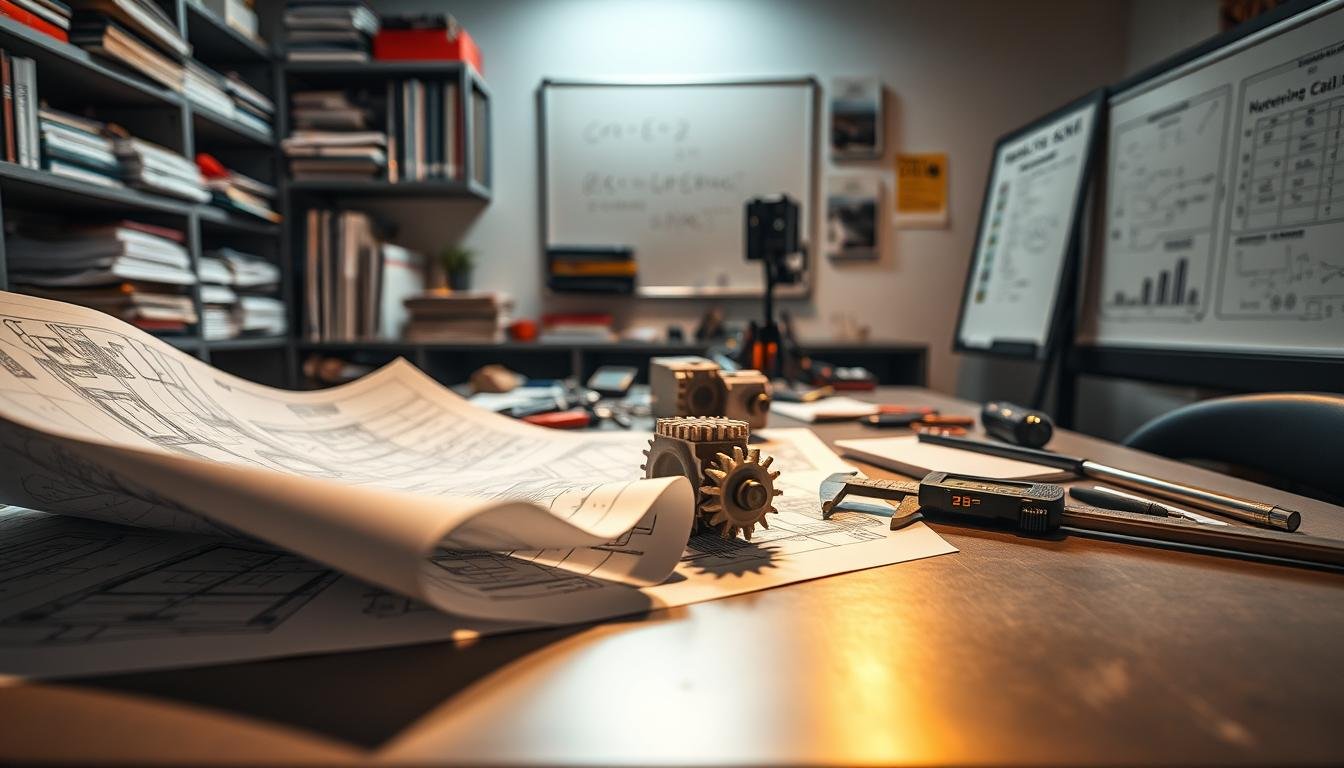In the world of mechanical engineering, case studies are key. They show how engineering ideas become real solutions. These detailed studies help us see how theories work in practice.
By looking at different case studies, we learn how engineers solve problems. This shows their big impact on business and technology. These studies are very important. They celebrate past successes and guide us towards the future.
Understanding the Importance of Case Studies:
Case studies in mechanical engineering are very important. They help engineers learn from real-world problems and solutions. By studying different cases, I can find strategies that work well in practice.
This learning not only helps me but also the whole field. It makes mechanical engineering better for everyone.
Case studies are also great for sharing knowledge. They bring together insights from various projects. This way, engineers can learn from each other’s experiences.
When we share our knowledge, we all get better. It leads to new ideas and improvements. This makes learning a never-ending process in mechanical engineering.
Innovative Case Studies Highlighting Mechanical Engineering:
In my journey through mechanical engineering, I found many innovative case studies. These examples show how engineers solve complex problems with creative solutions. Projects in robotics have led to big engineering breakthroughs, changing how we work.
Advances in automation have made factories more efficient. This has cut down on labor costs and increased production. It’s a big win for businesses.
Renewable energy systems have also seen major improvements. Engineers have made wind and solar power more effective. This helps the environment and creates jobs in new sectors.
Exploring new materials has been fascinating. Engineers have created lightweight composites and smart materials. These materials make products better, last longer, and are more sustainable.
These case studies show the power of mechanical engineering. They show how creativity and innovation can change industries. I’m excited to share more about the amazing things mechanical engineering can do.
Mechanical Engineering Projects That Changed Industries:
Technology has evolved, leading to many changes in various sectors. In cars, the rise of self-driving vehicles is a big leap. These cars use smart algorithms and sensors, showing how new designs and precision engineering can change things.
In airplanes, the Boeing 787 Dreamliner is a big step towards greener flying. It uses new materials and designs to save fuel. This shows how mechanical engineering can lead to better, more eco-friendly travel options.
Healthcare has also seen big changes thanks to mechanical engineering. The da Vinci Surgical System is a great example. It makes surgeries safer and less invasive, improving patient care. The impact of such technology is huge, setting new standards in medicine.
Real-World Applications of Mechanical Engineering:
Looking into real-world mechanical engineering shows its huge impact across many areas. I’ve seen many examples where theory turns into real solutions. For example, Toyota uses advanced systems to make production lines better and more efficient.
In the energy field, engineers create new wind turbines that use natural power. These turbines not only give us clean energy but also work with complex systems to perform well.
Automation is key in today’s industries, showing how mechanical engineering boosts work. For example, Amazon uses robots to improve how orders are filled. This makes things faster and cuts down on mistakes.
These examples show how important mechanical engineering is in solving big problems. By using basic principles, engineers help make things better and more efficient in many areas.
Mechanical Engineering: Analyzing Real-Life Challenges:
In my exploration of mechanical engineering, I’ve found that real-life challenges are complex. Each project has unique obstacles that need creative solutions. For example, engineers use finite element analysis (FEA) and computational fluid dynamics (CFD) to improve their designs.
My experience shows that solving these challenges requires careful attention to detail. It’s about understanding how forces affect mechanical systems. Through case studies, I’ve seen how these solutions lead to new technologies.
The journey through these challenges teaches us a lot. It shows how important testing and feedback are in engineering. As we solve each challenge, our knowledge grows, showing the true spirit of mechanical engineering.
Collaboration Between Mechanical Engineers and Other Disciplines:
Working together, mechanical engineers and experts from fields like electrical engineering, computer science, and civil engineering are key to solving complex problems. I’ve seen how teaming up can turn old ways of doing things into new, better methods. Projects that bring together different areas of expertise can tackle challenges from many sides.
When teams work together, they can come up with creative and efficient solutions. For example, in robotics, combining mechanical engineering with software development leads to better systems. These systems are more effective and meet user needs better.
Studies show that projects that bring together different areas of engineering often get better results. By using the strengths of each field, we can tackle tough issues and make new breakthroughs. Examples from the industry show that working together can lead to solutions that wouldn’t be possible alone.
The Role of Technology in Mechanical Engineering Case Studies:
In my study of mechanical engineering, I’ve seen how technology changes our problem-solving. Digital tools like CAD software have revolutionized design. They let engineers see designs in 3D, making them more precise and cutting down on mistakes.
Simulation tools are another big plus in modern engineering. They let engineers test ideas without making real prototypes. This saves time and money. I’ve seen how companies use these tools to make their products better.
Automation is also key in mechanical engineering’s growth. It makes manufacturing faster and more consistent. For example, a project used robots to improve assembly lines. This led to big gains in productivity.
Case Studies in Mechanical Design and Development:
Looking into mechanical design case studies shows us how engineering works in real life. Each story tells us about the challenges designers face. It shows us how they come up with new ideas and make them better.
For example, when working on a new appliance, I saw how ideas changed over time. It went from a simple idea to a working prototype.
One study was about making a vacuum cleaner better. The goal was to make it suck up dirt more efficiently without using too much energy. This needed a lot of knowledge about air and materials.
It showed how important testing is. It helps make sure the design works and gets even better with feedback.
These studies taught me a lot about making products. They showed how to balance what the product does, how much it costs, and how users feel about it. They also showed how important it is to keep up with what customers want and what the market needs.
Future Trends in Mechanical Engineering through Case Studies:
Looking at recent case studies shows big changes in mechanical engineering. Artificial intelligence is changing how designs are made. Now, engineers use AI to make designs better and more efficient.
There’s also a big push for sustainability. Many projects use green materials and save energy. This helps meet today’s environmental needs and sets the stage for a greener future.
Advanced manufacturing is another key area. 3D printing and automation are making production faster and cheaper. These new tools help engineers build complex designs quickly, cutting down on waste and costs.
From these studies, it’s clear that the future of engineering will be shaped by new technologies. This future will be more productive, sustainable, and innovative, thanks to teamwork and cutting-edge tools.
Resources for Further Exploration of Case Studies in Mechanical Engineering:
As I wrap up this look at mechanical engineering case studies, I want to share some great resources. A good place to start is the book “Engineering Design: A Systematic Approach” by G. H. Paul. It dives into real-life applications in mechanical engineering through case studies.
Also, check out academic journals like “Journal of Mechanical Engineering Science” and “Mechanical Engineering Magazine.” These offer detailed articles and research. They’re perfect for students and professionals looking to learn more. You’ll find in-depth analyses of past studies and new challenges and solutions.
For those who like learning through interactive experiences, try platforms like Coursera and edX. Universities offer free or low-cost courses there. These can help you understand mechanical engineering better and keep you up-to-date with the latest trends. Using these resources will make you appreciate mechanical engineering’s impact on our future.

